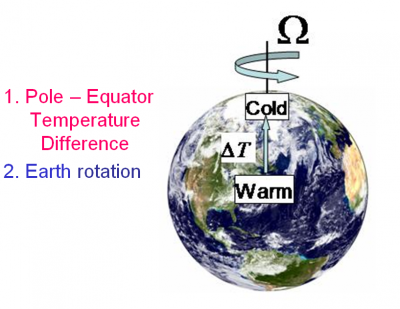Please see:
Intro_project3_slides and intro_project3_notes.
The atmosphere is warm and moist in the tropics, cold at dry at the poles. The equator-to-pole temperature gradient drives atmospheric winds which carry heat and moisture from the equator to the pole, offsetting the imbalance. Because the timescale of the resulting winds is days rather than hours, the motion is strongly influenced by the rotation of the earth.
In this project, then, we study these two ‘ingredients’:
- Differential heating (i.e. warming of the equator, cooling of the pole)
- Earth’s rotation,
whose interplay leads to the ‘general circulation of the atmosphere’ and accomplishes its heat and moisture transport.

We focus on both tropical (Hadley) and extra-tropical (eddying) circulation patterns. The Hadley circulation occurs at low latitudes and is axi-symmetric. The extra-tropical circulation is dominated by unsteady, non axi-symmetric motions familiar to us as weather systems. We study both regimes in the laboratory and using atmospheric data. See here the matrix of experiments.